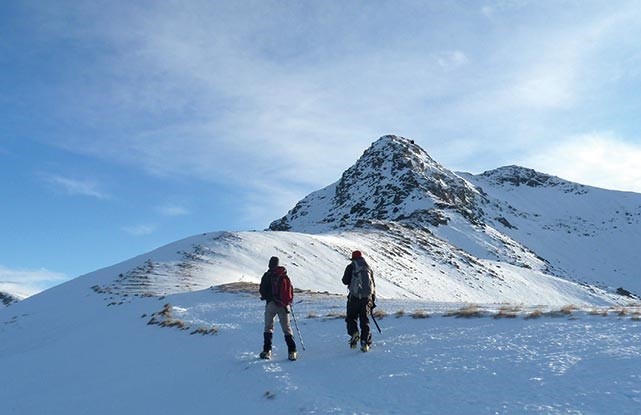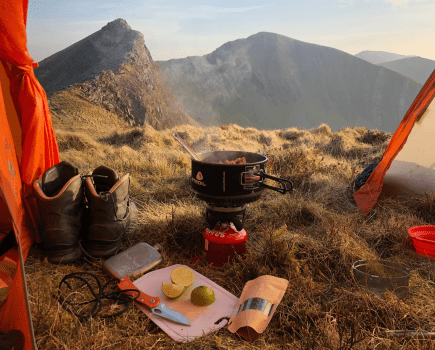Walking in winter is a wonderful. Plan ahead and take the right safety measures. Here are a few reminders…
CHECK THE FORECASTS
In winter that doesn’t just mean the weather forecasts (the Mountain Weather Information Service is at:mwis.org.uk) but also avalanche conditions. The Scottish Avalanche Information Service (sais.gov.uk) provides detailed info and the Felltop Assessor reports from the summit of Helvellyn are a useful resource for walkers in the Lake District (lakedistrictweatherline.co.uk).
LEAVE DETAILS
Make sure someone knows where you’re going, the route you’re taking and when you intend to be back.
GET YOUR LAYERS SORTED
It sounds obvious, but you don’t have to wear all your layers all the time. Carry spare clothing with you and if you ‘walk warm’ then save your insulating garments for when you stop. Excessive sweating will wet your clothing and reduce its power to insulate.
PRACTISE WALKING IN CRAMPONS AND ICE AXE ARRESTS
If you haven’t been out in spikes for a while, give yourself some practice on less serious terrain. You hope you’ll never need to carry out an ice axe arrest
for real, but practise those as well (wear a helmet to do it).
WORK AS A GROUP
When walking in a party, don’t forget to keep an eye on your companions. Others may find the terrain more challenging than you. If necessary, be prepared to change your route.
KNOW YOUR LIMITS
Winter in the mountains can be much more challenging than at other times of year. Even a familiar route on a hill you’ve visited before can bring unexpected difficulties under snow.
LOOK AFTER YOUR FACE
A balaclava, Buff or similar piece of kit can help to keep your nose and cheeks warm. If you’re lucky enough to get a bright day, wear sunscreen. Sunshine reflects off the snow so protect the underside of your nose and chin as well as the bits that point at the sun.
FUEL YOUR BODY
Heather Morning of the Mountaineering Council of Scotland says: “The human body is a bit like a car: it needs to have enough fuel, of the right sort, to run efficiently. Carbohydrates of both the slow and quick release varieties are best for fuelling a day on the hill. Keep your snacks easily accessible as it is unlikely that you will have the luxury of ‘stopping for lunch’ as you would in summer conditions, because when you stop you get cold very quickly.”
AVALANCHE BASICS
Watch out for slopes between 30 and 45 degrees, which are the most prone to avalanching. Convex slopes are more risky than concave ones. Watch out also for build-up of new snow, thawing conditions and signs of previous avalanches.
GIMME SHELTER
A group shelter or bothy bag will really come into its own if a member of your party has an injury, but can also be useful for lunch stops and checking the map in gnarly conditions.
GET YOUR NAV SORTED
Revise your navigation – it’s always a good idea to check your skills. Approximately a quarter of all mountain rescue incidents are the result of navigation errors.
ALLOW EXTRA TIME
Plunging through snow can mean that things take a lot longer than usual. And in the short days of winter, time can run out quickly.
TAKE SPARE GLOVES
At least one spare pair of gloves is sensible – but take two to be sure.
BEWARE OF CORNICES
Standing on a cornice is a very bad idea. Keep well back – you may not be able to judge exactly where the mountain ends and the cornice begins and in any case, cornices often break off at an angle. Walking or climbing underneath one can be risky too, because ofthe risk of avalanche if the cornice collapses due to temperature rises or human activity.
MAP AND COMPASS
A GPS device should not be relied upon as your sole navigation tool. Make sure you carry a map in a waterproof case, and a back-up one, as well as a spare compass.
YOUR GUIDING LIGHT
Don’t forget your headtorch – whether you expect to be out after dark or not. Carry spare batteries.
COTTON KILLS
Cotton clothing can significantly increase your risk of developing hypothermia in the winter mountains. Once wet it will lose any insulation properties and quickly cool your skin. Specialist outdoor clothing is designed to wick moisture away from the skin.
DON’T PUT ANYTHING DOWN
If you put your kit down on the ground it could blow away or get buried. Make sure your pack is large enough for you to be able to forage around inside without pulling everything out in order to reach your sandwiches.
PROTECT YOUR EYES
Pack wraparound sunglasses or ski goggles for navigating in wind-blown snow.
DRINK, DRINK, DRINK…
Good hydration is as important in winter as it is in summer. On very cold days, make sure you insulate your hydration bladder or bottle, or take a flask. Hot drinks can be good for morale as well as warmth and hydration.
KNOW YOUR AXE
Many people think ‘arrest’ when they think of ice axes, but it’s more important to avoid sliding in the first place. Learn to use your axe as a walking aid, plunging it securely into the snow to help avoid slips.
CARRY A SURVIVAL BAG
A lightweight polythene survival bag will act as a barrier against wind and snow in the case of an injury. A group shelter can be an alternative.
TUCK YOUR STRAPS AWAY
Keep the straps on your rucksack and any other kit tucked away in order to prevent them whipping in the wind and slapping you in the face.
A GOOD FIT
Make sure your boots fit you well and that your crampons are suited to and fitted properly on your boots. Ill-fitting boots can become uncomfortable once you start kicking steps. And ill-fitting crampons can be dangerous.
TAKE IT IN TURNS
If you’re walking in a group, you can prevent getting too tired by taking it in turns to break through deep snow or kick steps. People following behind the trail-breaker can make things easier for those at the back by stepping into the back of their footsteps, allowing the accumulated steps to merge into one long trench.
PROTECT YOUR COMPASS
Over recent years there have been a number of incidents of reversed polarity, where compass needles have been partially or totally reversed as a result of close proximity to an electronic gadget such as a mobile phone. So keep your compass away from other such pieces of kit, always carry a spare one, and get into the habit of checking it’s accurate before you leave the house.
STEP ON UP
Learn an efficient technique for kicking steps to ascend snow that’s not hard enough to require crampons. Swing from the knee and use the edges of your boots to saw into the snow.
BE PREPARED TO REPAIR
Carry a basic maintenance kit for your crampons in case of breakages – a replacement strap, a multi-tool, some duct tape and cable ties could all be useful. You may also want to carry spare nuts and bolts.
FIRST AID
Take a human repair kit too – a first aid kit is always worth the extra weight.
DON’T GET SPIKED
Crampons and ice axes have points (that’s the point!). Watch out for catching them on clothes, yourself or even other members of your party. When not in use, carry your axe securely. Keep your laces securely tied and loose trousers tucked into gaiters to avoid snagging on spikes.
UNDERSTAND AVALANCHES
You cannot be too educated when it comes to avalanches. Read and understand as much as you can. An avalanche awareness quiz is available on the Glenmore Lodge website at:glenmorelodge.org.uk/outdoor-resources/avalanche-information/avalanche-quiz/. If you think you need more knowledge, take an avalanche safety course.
IT DOESN’T NEED TO BE WHITE TO BE SLIPPERY
An overnight drop in temperature can allow ice to form even on grassy hills where no snow has fallen. Because the slopes look green, people assume they’re not icy. Be prepared to change your route if necessary.
BALLING UP
Watch out for balled-up snow underneath your crampons. It can usually be cleared by a few quick taps of the axe or by scraping with the adze.
‘EASIER’ TERRAIN
Don’t assume your axe and crampons are only for use on steep terrain or icy ground. Snowy or frozen slopes of any angle can require an axe and crampons for safe travel.
KNOW YOUR BOOTS
Winter boots don’t need to be heavy and fully rigid but a stiff sole is important for step-kicking and for crampon attachment. In descent, square-cut heels are much more secure than rounded ones.
WINTER CAN LAST A WHILE!
You may be prepared for winter conditions in January, February and March but do you put your ice axe in the car when travelling to the hills in May? It’s worth it, particularly in Scotland, where winter conditions on the hill often last well into what many would consider spring.
LEARN FROM THE EXPERTS
No matter how much you read, nothing beats proper training. Head to one of the national centres (Glenmore Lodge in Scotland, Plas y Brenin in Wales, Tollymore in Northern Ireland) or take a course with a specialistwinter skills instructor. An instructor with the Winter Mountain Leader award will be able to take you through some of the basics, but for full winter instruction seek out someone with the Mountain Instructor Certificate.







